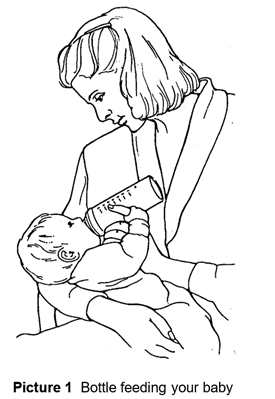Choosing a Bottle Flow Rate

Your baby’s bottle flow rate is the rate at which human milk or infant formula moves from the bottle nipple into an infant’s mouth. The bottle flow rate is important because if it is too slow your baby may work too hard to get milk. If the flow rate is too fast, they may have a hard time with the faster flow. Most bottle brand companies give a flow rate name on the nipple, such as, ‘preemie,’ ‘slow,’ ‘medium’ or ‘fast.’ Other brands give a flow rate number, such as 0, 1, 2 or 3. The names and numbers tell how fast the flow rate is. Almost every bottle brand attaches an age range to their flow rate.
Choosing a Bottle Nipple

Every baby has their own feeding style. They may need a slower bottle nipple or a faster bottle nipple depending on their pace (how fast or slow they eat). The pace may not match their age or size nipple, as recommended on the bottle packaging. Babies who are fed by both breast/chest and bottle may benefit from a slower flowing bottle nipple. This helps match the flow rate of human milk during breast/chest feeding. However, most babies who are born around their due date will be able to use a newborn flow rate (such as “level 1” or “slow flow”) whether drinking human milk or formula.
There are many bottle brands, nipple sizes and styles of bottles to choose from. Some bottles are designed to look like a human nipple. Other bottles are designed to decrease colic or reflux. Finding the right bottle is unique to each baby.
When to Change Nipples
If your baby is healthy, growing and enjoys eating from their bottle, continue following your baby’s pace. There is no need to move up a level based on age. A baby may be on the same level nipple the whole time they eat from a bottle. This is okay. However, babies will show signs if the flow is too slow or too fast.
- If your baby is ready to move up to a faster flow nipple, they may show these signs:
- Taking longer to finish eating
- Fast sucking with not many swallows (bottle nipple may collapse)
- Getting fussy while eating
- Sometimes the nipple flow rate can be too fast for your baby. If they show any of these signs while eating, try a slower flowing nipple:
- Gulping
- Choking
- Hard swallowing
- Coughing
- Increased drooling
- Refusing to eat
Signs You Need a New Bottle or Nipple
Nipples that are weak or worn out are more likely to tear or be a choking hazard. They must be replaced right away. To test a nipple’s strength, pull hard on the end of the nipple. This is called the bulb. The nipple should return to its original shape. If it does not, throw it away.
The following are signs that your bottle nipple may be getting weak:
- Changing color
- Thinning
- Stickiness or swelling
- Cracks, tears, or breaks
Other Important Information
- If the bottle is leaking, make sure the bottle ring or collar is not too tight or too loose.
- If the bottle is leaking and the bottle system has an anti-colic insert, make sure the insert is in place.
- Make sure all bottle parts are put together before adding human milk or formula
HH-IV-244 ©2021, Nationwide Children’s Hospital

